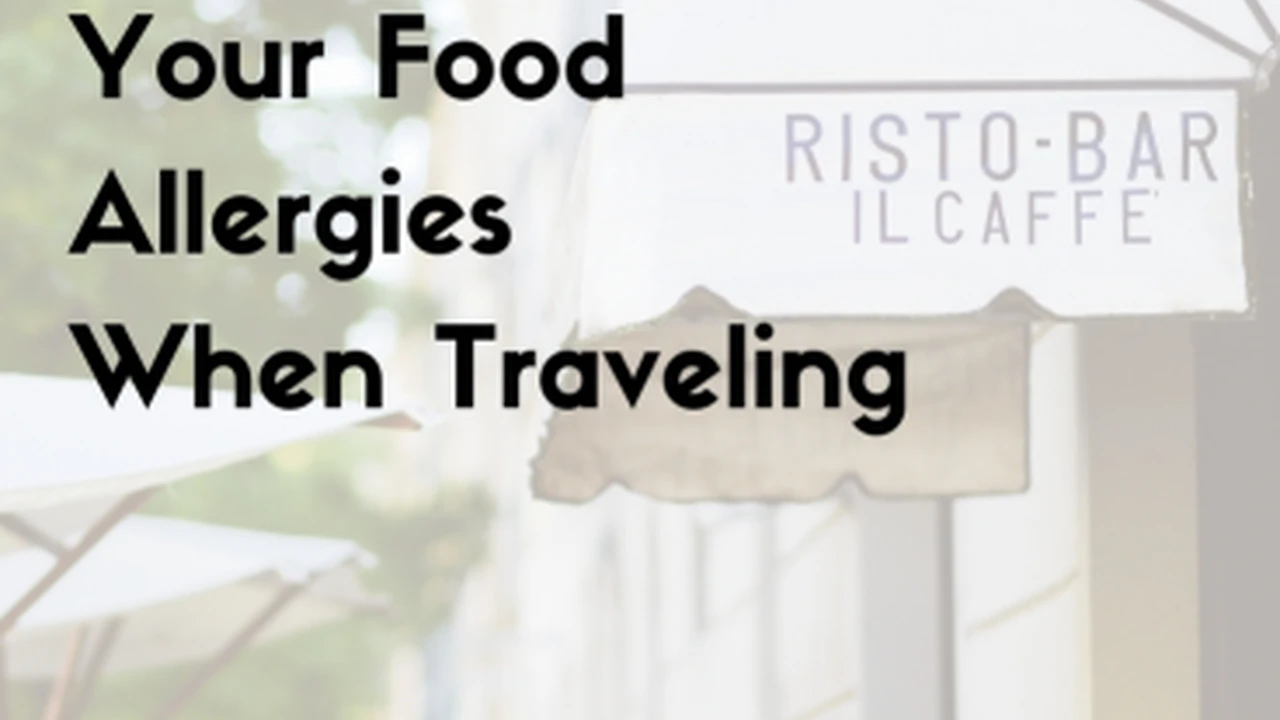Food allergies in Thailand: How to communicate your needs

Understanding Food Allergies in Thailand The Basics
Alright, so you're heading to Thailand – land of smiles, stunning temples, and seriously amazing food. But what if you've got food allergies? Don't freak out! Thailand can still be an incredible culinary adventure. It just takes a little planning and knowing how to communicate your needs. This guide is your new best friend, helping you navigate the Thai food scene with confidence.
First things first: food allergies are a real thing, and they're becoming more common worldwide. In Thailand, while awareness is growing, it's not quite as widespread as in some Western countries. This means you need to be proactive. We're talking about understanding common allergens, knowing how to say what you can't eat in Thai, and being prepared for potential misunderstandings.
Common allergens to watch out for in Thai cuisine include peanuts, shellfish (especially shrimp paste, which is *everywhere*), soy sauce (often containing wheat), fish sauce, and MSG (monosodium glutamate). Gluten intolerance is also becoming more recognized. Many Thai dishes rely on these ingredients for flavor, so it's crucial to be specific when ordering.
Learning Essential Thai Phrases for Allergy Communication Key Phrases
Okay, time to learn some Thai! Don't worry, you don't need to become fluent. Just a few key phrases will go a long way. Here are some essentials, along with phonetic pronunciations (which are approximate, but will get you close!):
- "แพ้ [allergen]" (Pae [allergen]): "I'm allergic to [allergen]." For example, "แพ้ถั่ว" (Pae Tua) means "I'm allergic to peanuts."
- "ไม่ใส่ [allergen] ได้ไหม" (Mai sai [allergen] dai mai?): "Can you not put [allergen] in?" For example, "ไม่ใส่ถั่วได้ไหม" (Mai sai Tua dai mai?) means "Can you not put peanuts in?"
- "มี [allergen] ไหม" (Mee [allergen] mai?): "Does it contain [allergen]?" For example, "มีถั่วไหม" (Mee Tua mai?) means "Does it contain peanuts?"
- "ไม่กิน [allergen]" (Mai gin [allergen]): "I don't eat [allergen]." For example, "ไม่กินอาหารทะเล" (Mai gin a-haan ta-lay) means "I don't eat seafood."
- "ช่วยเขียนเป็นภาษาไทยได้ไหม" (Chuay khian pen pha-sa Thai dai mai?): "Can you please write it in Thai?" This is super helpful! Have the restaurant write down your allergies in Thai. This prevents miscommunication and allows them to communicate with the kitchen directly.
Pro Tip: Write these phrases down on a piece of paper or save them on your phone. Showing them to the staff is often easier than trying to pronounce them perfectly (although your effort will be appreciated!). Many restaurants are happy to accommodate requests if they understand the seriousness of the situation.
Navigating Thai Restaurants with Allergies Practical Tips and Strategies
So, you've got your phrases ready. Now what? Here's how to navigate Thai restaurants with confidence:
- Choose your restaurant wisely: Smaller, family-run restaurants are often more accommodating than large chain restaurants. They're usually more willing to adjust recipes.
- Be specific: Don't just say "I have allergies." Clearly state *exactly* what you're allergic to. The more specific you are, the better.
- Ask about ingredients: Don't be afraid to ask about every ingredient in a dish. Even if something seems simple, it might contain hidden allergens. For example, many sauces contain fish sauce or shrimp paste.
- Point to ingredients: If possible, point to the ingredients you're concerned about on the menu or in the kitchen. Visual cues can be very helpful.
- Consider ordering simple dishes: Sometimes, the simplest dishes are the safest. For example, steamed rice with grilled chicken or vegetables might be a better option than a complex curry.
- Avoid buffets: Buffets are a cross-contamination nightmare! It's nearly impossible to guarantee that allergens haven't come into contact with other dishes.
- Bring your own safe snacks: This is especially important if you have severe allergies. Having a safe snack on hand can prevent a potential allergic reaction if you can't find anything suitable to eat.
- Carry an epinephrine auto-injector (EpiPen): If you have a severe allergy, always carry your epinephrine auto-injector and make sure you know how to use it. Inform someone you're traveling with about your allergy and how to administer the EpiPen in case of emergency.
Understanding Thai Ingredients and Cross Contamination Concerns
Let's dive a little deeper into common Thai ingredients and potential cross-contamination issues:
- Fish Sauce (น้ำปลา – Nam Pla): This is a staple in Thai cuisine. It's made from fermented fish and is incredibly salty and umami-rich. It's used in everything from curries to stir-fries to dipping sauces. Always ask if a dish contains fish sauce.
- Shrimp Paste (กะปิ – Kapi): Another common ingredient, especially in Southern Thai cuisine. It has a very strong, pungent smell and is used to add depth of flavor to curries and sauces. Be very careful if you're allergic to shellfish.
- Soy Sauce (ซีอิ๊ว – See Ew): Most soy sauces contain wheat. If you're gluten-free, look for tamari, which is a gluten-free soy sauce alternative. However, even tamari can sometimes be processed in facilities that also handle wheat, so always check the label.
- Peanuts (ถั่ว – Tua): Peanuts are used in many Thai dishes, including Pad Thai, Massaman curry, and peanut sauce. Be extremely careful if you're allergic to peanuts.
- MSG (ผงชูรส – Pong Choo Rot): MSG is a flavor enhancer that's widely used in Thai cuisine. While not an allergen for everyone, some people are sensitive to it and can experience symptoms like headaches, flushing, and sweating. You can ask restaurants to not add MSG to your food.
Cross-Contamination: Even if a dish doesn't explicitly contain an allergen, there's always a risk of cross-contamination in the kitchen. This is especially true in busy restaurants where multiple dishes are being prepared simultaneously. Communicate your concerns to the staff and ask them to take extra precautions to prevent cross-contamination. For example, ask them to use clean utensils and cutting boards when preparing your food.
Recommended Allergy Friendly Products Available in Thailand
Finding allergy-friendly products in Thailand can sometimes be a challenge, but it's definitely possible! Here are some recommendations, along with where you might find them and price ranges (prices are approximate and can vary):
- Gluten-Free Soy Sauce (Tamari): Look for brands like Kikkoman Gluten-Free Tamari or San-J Tamari. You can find these in larger supermarkets like Villa Market, Gourmet Market (in shopping malls like Siam Paragon and EmQuartier), and sometimes in health food stores.
- Usage Scenario: Perfect for stir-fries, dipping sauces, and marinades.
- Product Comparison: Kikkoman is widely available and a reliable brand. San-J is often considered higher quality with a richer flavor.
- Price Range: 150-300 THB per bottle.
- Peanut-Free Peanut Butter Alternatives: SunButter (made from sunflower seeds) is a great alternative. You might find it in Villa Market or online retailers.
- Usage Scenario: Great for sandwiches, smoothies, or as a dip for fruits and vegetables.
- Product Comparison: SunButter has a slightly different taste than peanut butter, but it's a good substitute. Consider trying different brands to find your favorite.
- Price Range: 200-400 THB per jar.
- Dairy-Free Milk Alternatives: Soy milk, almond milk, coconut milk, and oat milk are widely available in most supermarkets (Big C, Tesco Lotus, etc.).
- Usage Scenario: Use in coffee, tea, cereal, smoothies, or for baking.
- Product Comparison: Soy milk is a good source of protein. Almond milk is lower in calories. Coconut milk adds a creamy texture. Oat milk is often preferred for its taste and texture.
- Price Range: 50-150 THB per carton.
- Gluten-Free Noodles: Look for rice noodles (Sen Yai, Sen Lek, Sen Mee) which are naturally gluten-free and widely used in Thai cuisine. You can find them in any supermarket.
- Usage Scenario: Perfect for Pad Thai, noodle soups, and stir-fries.
- Product Comparison: Sen Yai are wide, flat noodles. Sen Lek are thin rice noodles. Sen Mee are very thin, vermicelli-like noodles. Choose the type that best suits your dish.
- Price Range: 20-50 THB per package.
- Allergy-Friendly Snacks: Look for simple snacks like fresh fruits (mangoes, bananas, pineapples), rice cakes, or plain yogurt (dairy-free options available). You can find these in most convenience stores and supermarkets.
- Usage Scenario: Great for a quick and safe snack on the go.
- Product Comparison: Choose fruits that are in season for the best flavor and price.
- Price Range: Varies depending on the product.
Dealing with Language Barriers and Potential Misunderstandings
Even with your best efforts, language barriers can sometimes lead to misunderstandings. Here's how to handle them:
- Be patient and polite: Remember that most people are trying to help you. Frustration won't get you anywhere.
- Use visual aids: Pictures can be incredibly helpful. Show pictures of the allergens you're concerned about.
- Ask for a manager: If you're having trouble communicating with the staff, ask to speak to a manager. They may have a better understanding of food allergies and be able to assist you.
- Don't be afraid to walk away: If you're not confident that the restaurant understands your needs, it's better to err on the side of caution and find another place to eat.
- Consider a translation card: There are translation cards specifically designed for people with food allergies. These cards list common allergens in multiple languages and can be very helpful when traveling abroad. You can find these online and print them out.
Emergency Preparedness What to Do in Case of an Allergic Reaction
Even with the best precautions, allergic reactions can still happen. Here's what to do in case of an emergency:
- Recognize the symptoms: Symptoms of an allergic reaction can range from mild (hives, itching, swelling) to severe (difficulty breathing, wheezing, dizziness, loss of consciousness).
- Administer epinephrine (EpiPen): If you have an epinephrine auto-injector, use it immediately if you experience any symptoms of a severe allergic reaction.
- Call for help: Call for emergency medical assistance (dial 1669 in Thailand).
- Inform others: Tell someone you're traveling with or a member of the restaurant staff that you're having an allergic reaction.
- Seek medical attention: Even if your symptoms subside after using an EpiPen, it's important to seek medical attention as soon as possible.
Enjoying Thai Cuisine Safely and Confidently
Don't let food allergies stop you from enjoying the incredible culinary experiences that Thailand has to offer. With a little preparation, clear communication, and a healthy dose of caution, you can navigate the Thai food scene with confidence and have an amazing trip!
Remember to be proactive, learn key phrases, choose restaurants wisely, and always be prepared for potential emergencies. Happy travels and happy eating!
:max_bytes(150000):strip_icc()/277019-baked-pork-chops-with-cream-of-mushroom-soup-DDMFS-beauty-4x3-BG-7505-5762b731cf30447d9cbbbbbf387beafa.jpg)






